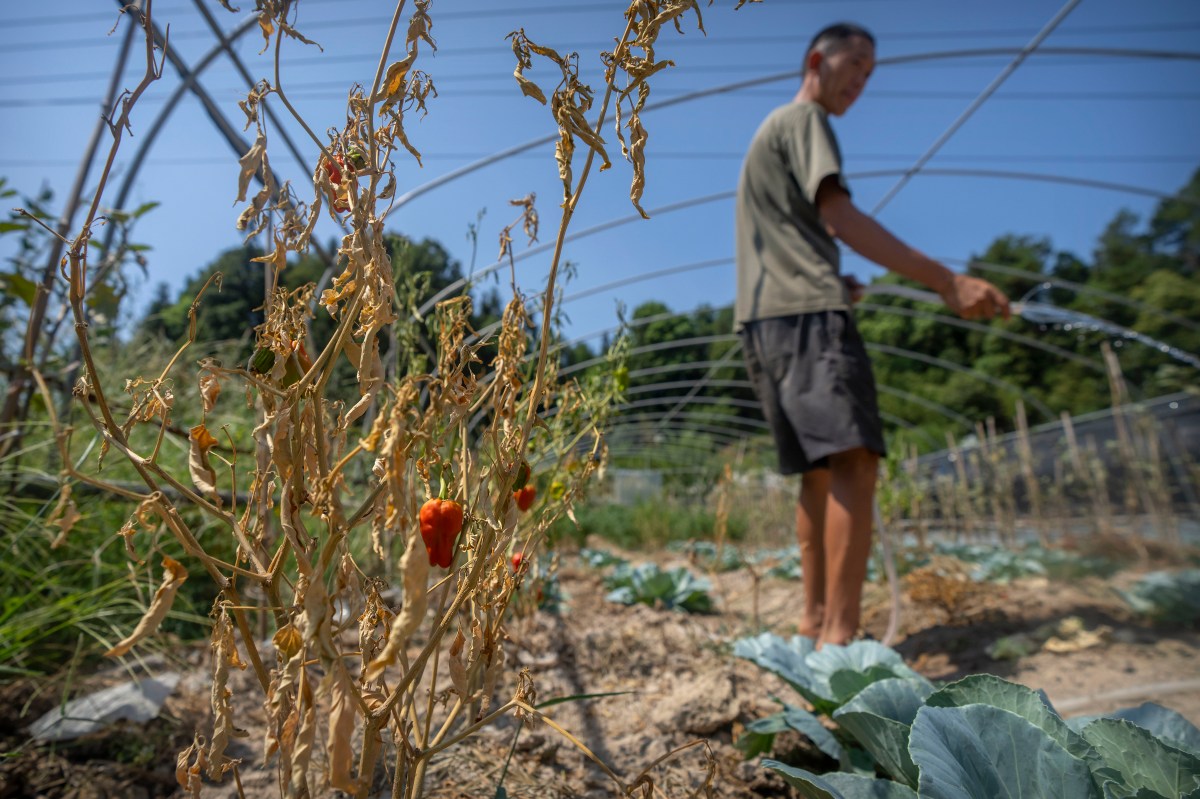LONGQUAN, China (AP) — Hundreds of persimmon trees that should be loaded with yellow fruit lie wilted in Gan Bingdong’s greenhouse in southwestern China, adding to mounting farm losses in a scorching summer that is the country’s driest in six decades.
Gan’s farm south of the industrial metropolis of Chongqing lost half its vegetable crop in heat as high as 41 degrees Celsius (106 Fahrenheit) and a drought that has shrunk the giant Yangtze River and wilted crops across central China.
Gan’s surviving eggplants are no bigger than strawberries. A reservoir beside his farm has run dry, forcing him to pump groundwater.
“This year’s high temperatures are very annoying,” Gan said.
Drought conditions across a swath of China from the densely populated east across central farming provinces into eastern Tibet have “significantly increased,” the national weather agency said Saturday.
The forecast called for high temperatures and no rain for at least three more days from Jiangsu and Anhui provinces northwest of Shanghai, through Chongqing and Sichuan provinces to the east of Tibet.
Local authorities were ordered to “use all available water sources” to supply households and livestock, the weather agency said.
The biggest impact is in Sichuan, where factories have been shut down and offices and shopping malls told to turn off air-conditioning after reservoirs to generate hydropower fell to half their normal levels.
The province of 94 million people gets 80% of its electricity from hydropower dams.
Factories that make processor chips for smartphones, auto components, solar panels and other industrial goods were shut down for at least six days through Saturday. Some say output will be depressed while others say supplies to customers are unaffected.
The shutdowns add to challenges for the ruling Communist Party as President Xi Jinping, the country’s most powerful leader in decades, prepares to try to break with tradition and award himself a third five-year term as leader at a meeting in October or November.
Growth in factory output and retail sales weakened in July, setting back China’s economic recovery after Shanghai and other industrial centers were shut down starting in late March to fight virus outbreaks.
The economy grew by just 2.5% over a year earlier in the first half of 2022, less than half the official annual goal of 5.5%.
State-run utilities are shifting power to Sichuan from other provinces. Authorities used fire trucks to deliver water to two dry villages near Chongqing.
In Hubei province, east of Chongqing, 220,000 people needed drinking water, while 6.9 million hectares (17 million acres) of crops were damaged, the provincial government said Saturday. It declared a drought emergency and released disaster aid.
In Sichuan, 47,000 hectares (116,000 acres) of crops have been lost and 433,000 hectares (1.1 million acres) damaged, the provincial disaster committee said Saturday. It said 819,000 people faced a shortage of drinking water.
Authorities in Chongqing say an estimated 1 million people in rural areas will face drinking water shortages, the Shanghai news outlet The Paper reported.
Gan, the farmer south of Chongqing, said he has lost one-third of his persimmon plants.
Farmers in the area usually harvest rice in late August or September but plan to finish at least two weeks early before plants die, according to Gan.
A community reservoir beside Gan’s farm is nearly empty, leaving a pool surrounded by cracked earth. After supply canals ran dry, it sprang a leak and heat accelerated evaporation. Gan is pumping underground water for irrigation.
“If the high temperature comes every year, we will have to find a solution such as to build up nets, daily irrigation or to install a spray system to reduce the loss,” Gan said.
Meanwhile, other areas have suffered deadly flash floods.
Flooding in the northwestern province of Qinghai killed at least 23 people and left eight missing, the official Xinhua News Agency reported, citing local authorities.
Mudslides and overflowing rivers late Thursday hit six villages in Qinghai’s Datong county, the report said. Some 1,500 people were forced out of their homes.
AP video producer Olivia Zhang contributed.
Follow AP’s coverage of the Asia-Pacific region at https://apnews.com/hub/asia-pacific

























